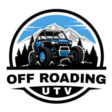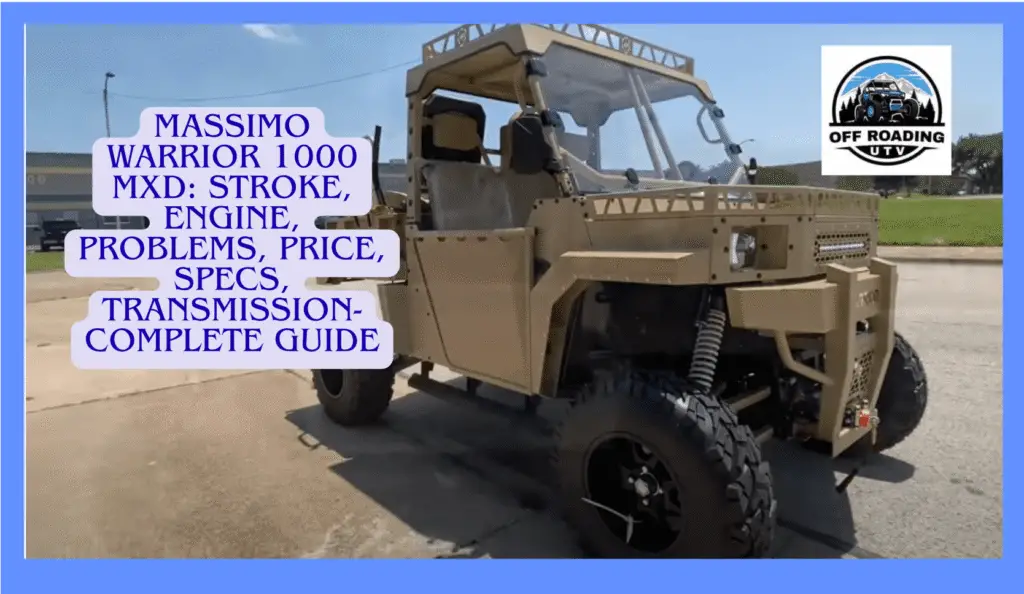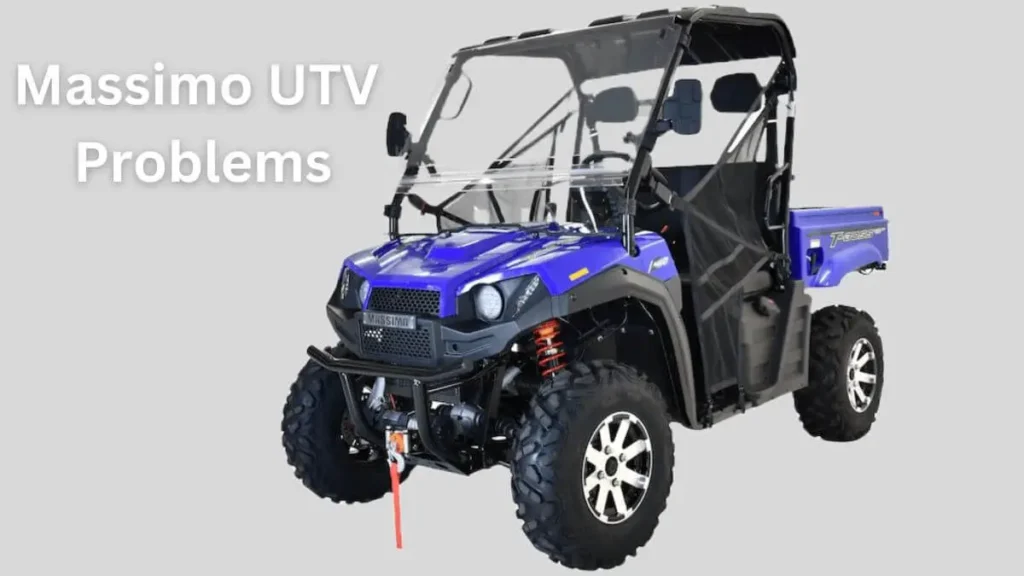The Massimo Warrior 1000 MXD is a durable side-by-side UTV manufactured by Massimo Motors, a Texas-based subsidiary of the Massimo Group Equipped with an 85-horsepower V-Twin engine, automatic CVT transmission, and selectable 4WD, this vehicle excels in utility tasks and off-road adventures. Designed for farmers, ranchers, construction professionals, and outdoor enthusiasts, it features a 1000cc 4-stroke engine, 13.8-inch ground clearance, and a 1763-pound towing capacity. Priced at $18,399.99 for the 2024 model, it delivers competitive value against brands like Polaris. This guide answers critical questions about the Massimo UTV, covering its engine, transmission, specifications, common issues, pricing, and comparisons.
What Is the Massimo Warrior 1000 MXD?
The Massimo Warrior 1000 MXD is a side-by-side UTV engineered for utility and off-road performance. Powered by a 1000cc V-Twin engine producing 85 horsepower, it supports tasks like towing, hauling, and navigating rugged terrains. Its selectable 2WD/4WD system, 29-inch all-terrain tires, and 13.8-inch ground clearance ensure adaptability across diverse environments. The vehicle includes a 12.6-cubic-foot hydraulic dump bed, a 4500-pound winch, and a 10-inch touchscreen display with GPS and rear camera. Available in camo, red, quicksand, and black, its electrophoretic-coated frame resists corrosion, making it suitable for farming, ranching, construction, and recreational trail riding.
- Dimensions: 116 x 74 x 83 inches
- Wheelbase: 89 inches
- Dry Weight: 1892 pounds
- Colors: Camo, red, quicksand, black
- Applications: Farming, ranching, construction, off-roading
What Powers the Massimo Warrior 1000 MXD’s Engine?
The Massimo Warrior 1000 MXD features a 4-stroke, 2-cylinder V-Twin engine with a 1000cc displacement, delivering 85 horsepower. This liquid-cooled engine employs a Delphi Electronic Fuel Injection (EFI) system for precise fuel delivery, ensuring consistent performance in demanding conditions. The single overhead cam (SOHC) configuration optimizes power output for tasks like towing or climbing steep inclines. The engine’s design prioritizes durability, with regular maintenance extending its lifespan.
- Displacement: 1000cc
- Horsepower: 85 HP
- Cooling: Liquid-cooled
- Fuel System: Delphi EFI
- Ignition: ECU-controlled
What Transmission System Drives the Massimo Warrior 1000 MXD?
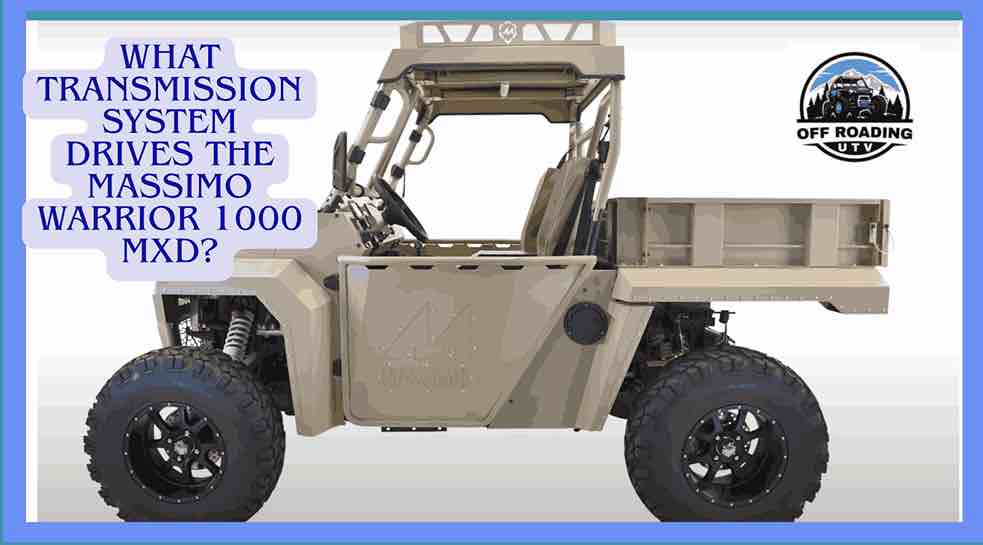
The Massimo Warrior 1000 MXD uses an automatic CVT (Continuously Variable Transmission) with Park, Reverse, Neutral, High settings, paired with a shaft drive system. This setup ensures seamless power transfer across terrains. The selectable 2WD/4WD system with a locking differential enhances traction, allowing operators to switch between 2WD for fuel efficiency and 4WD for challenging surfaces like mud or gravel.
- Transmission: Automatic CVT (P/R/N/H)
- Drive System: Selectable 2WD/4WD, shaft drive
- Differential: Locking for enhanced traction
What Are the Common Problems with the Massimo Warrior 1000 MXD?
The Massimo Warrior 1000 MXD faces occasional issues that require attention to maintain performance:
- Odometer Malfunctions: Incorrect altitude settings disrupt functionality, resolved by resetting the battery or ECU.
- CAN Bus Failures: Faulty CAN Bus systems limit speeds to 25 mph, requiring replacement.
- Clutch Wear: Worn clutches reduce power delivery, addressed with a clutch kit (e.g., Massimo OEM #67890).
- Fuel System Issues: Clogged fuel filters or faulty injectors cause stalling, fixed by cleaning or replacing components.
- Overheating: Extreme conditions may overheat the engine, mitigated by checking coolant levels regularly.
How Much Does the Massimo Warrior 1000 MXD Cost?
The 2024 Massimo Warrior 1000 MXD retails at $18,399.99, offering a cost-effective alternative to competitors. The Massimo Warrior 1000 MXD Crew, with six seats, costs $21,999.99. Older models, like the 2022 version, are priced higher at $25,999, despite lower specs (72 HP, 1500-pound towing capacity). The 2024 model’s enhanced features make it a better value.
- 2024 MXD Price: $18,399.99
- 2024 MXD Crew Price: $21,999.99
- Comparison: Polaris Ranger XP 1000 ($22,999)
What Are the Specifications of the Massimo Warrior 1000 MXD?
The Massimo Warrior 1000 MXD combines utility and off-road capabilities with precise specifications:
- Dimensions: 116 x 74 x 83 inches
- Wheelbase: 89 inches
- Ground Clearance: 13.8 inches
- Towing Capacity: 1763 pounds
- Cargo Bed Capacity: 12.6 cubic feet
- Fuel Tank Capacity: 7.95 gallons
- Dry Weight: 1892 pounds
- Tires: Front (29 x 9 x 14), Rear (29 x 11 x 14)
- Suspension: Dual A-arm with adjustable Yearben coilovers
- Brakes: Dual piston calipers (front), single piston calipers (rear)
- Winch: 4500-pound capacity
- Lighting: LED headlights, light bar, 4D series lights
- Display: 10-inch touchscreen with GPS, odometer, rear camera
How Does the Massimo Warrior 1000 MXD Compare to the MXD Crew?
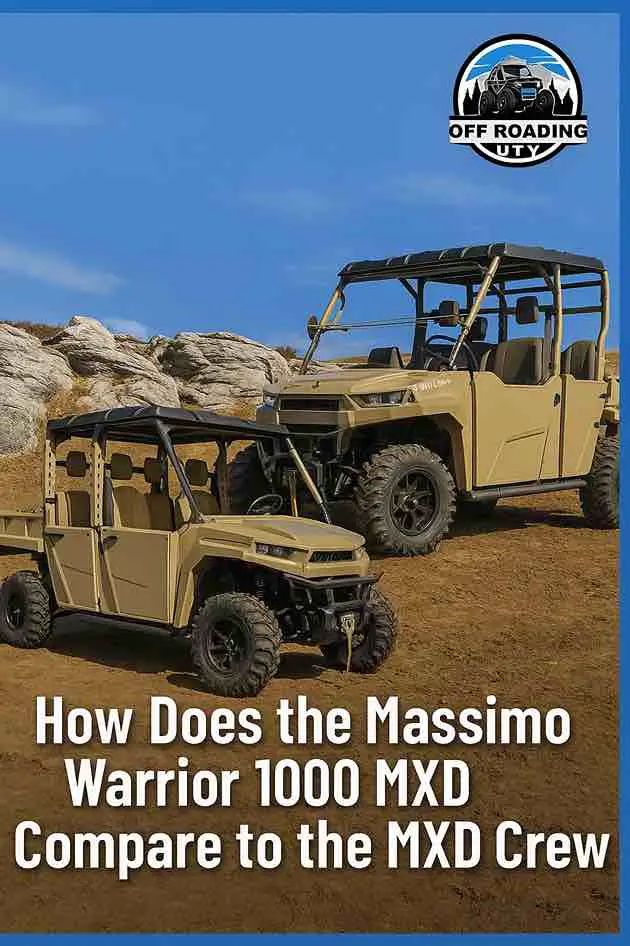
The Massimo Warrior 1000 MXD Crew extends the MXD’s capabilities with additional seating and features:
- Seating: MXD (4 seats, 2 jump seats), MXD Crew (6 seats)
- Winch Capacity: MXD (4500 lbs), MXD Crew (3500 lbs)
- Ground Clearance: MXD (13.8 inches), MXD Crew (13.78 inches)
- Fuel Capacity: MXD (7.95 gallons), MXD Crew (7.9 gallons)
- Additional Features in MXD Crew: Electric power steering, metal roof, half doors
- Price: MXD ($18,399.99), MXD Crew ($21,999.99)
The MXD suits solo or small-group tasks, while the MXD Crew accommodates larger groups.
How Does the Massimo Warrior 1000 MXD Compare to Polaris UTVs?
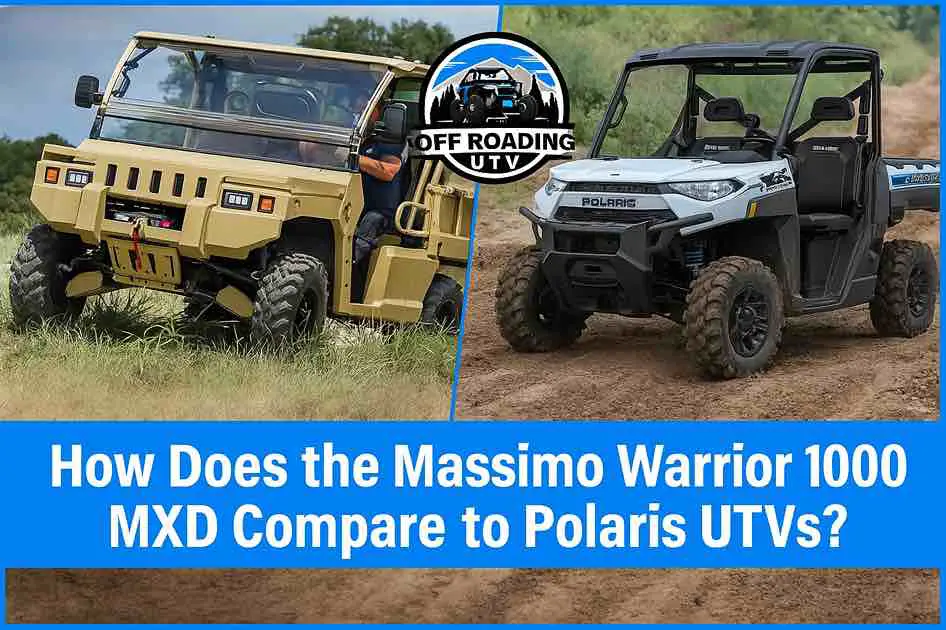
The Massimo Warrior 1000 MXD rivals Polaris UTVs like the Polaris Ranger XP 1000:
- Engine: MXD (85 HP, 1000cc V-Twin), Ranger XP 1000 (82 HP, 999cc)
- Towing Capacity: MXD (1763 lbs), Ranger XP 1000 (2500 lbs)
- Price: MXD ($18,399.99), Ranger XP 1000 ($22,999)
- Features: MXD includes touchscreen; Ranger offers advanced suspension
The MXD delivers better value, while Polaris excels in towing capacity. Explore Massimo UTV vs. Polaris UTV Comparison.
How Does the Massimo Warrior 1000 MXD Compare to the Massimo MXU 6?
The Massimo MXU 6 is a smaller UTV with distinct specifications:
- Engine: MXD (85 HP, 1000cc), MXU 6 (25 HP, 493cc)
- Seating: MXD (4 seats), MXU 6 (2 seats)
- Towing Capacity: MXD (1763 lbs), MXU 6 (1200 lbs)
- Price: MXD ($18,399.99), MXU 6 ($9,999)
The MXD outperforms the MXU 6 in power and capacity, ideal for heavy-duty tasks.
What Features Enhance the Massimo Warrior 1000 MXD’s Performance?
The Massimo Warrior 1000 MXD includes features that improve functionality:
- Selectable 4WD: Adapts to terrain conditions
- Hydraulic Dump Bed: Simplifies unloading
- LED Lighting: Enhances visibility
- Adjustable Suspension: Ensures smooth rides
- 10-Inch Touchscreen: Provides navigation and diagnostics
How Do You Maintain the Massimo Warrior 1000 MXD?
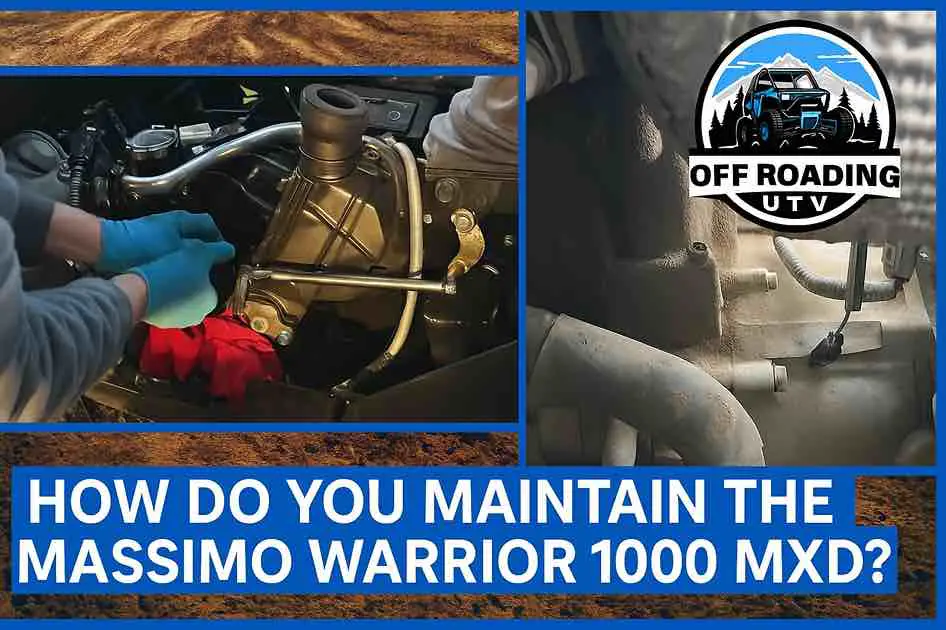
Regular maintenance extends the MXD’s lifespan:
- Oil Change: Use 10W-40 synthetic oil (2.5 quarts); replace filter (Massimo OEM #12345)
- Fuel System: Inspect filters and injectors every 500 miles
- Clutch: Check clutch kits every 1000 miles
- Cooling System: Monitor coolant to prevent overheating
- Battery: Inspect 12V, 30Ah battery monthly
Consult Massimo Warrior Service Manual for detailed schedules.
What Accessories Are Compatible with the Massimo Warrior 1000 MXD?
Enhance the MXD with:
- Snow Plow: For winter clearing
- Windshield: Full tilting for weather protection
- Speakers: Aftermarket audio systems
- Heater: For cold-weather comfort
- Muffler Silencer: Reduces exhaust noise
What Are the Common Complaints About the Massimo Warrior 1000 MXD?
Users report issues like:
- Operational Errors: Reset ECU for odometer issues
- Customer Service: Contact Massimo’s 1000+ service centers
- Parts Availability: Source from authorized dealers
What Warranty Covers the Massimo Warrior 1000 MXD?
The 12-month limited warranty includes:
- Engine and Drivetrain: 12 months
- Clutch and ECU: 180 days
- Battery: 30 days (with vehicle purchase)
How Does the Massimo Warrior 1000 MXD Perform Off-Road?
The MXD excels off-road due to:
- Ground Clearance: 13.8 inches for obstacles
- Tires: 29-inch all-terrain for grip
- Suspension: Dual A-arm for stability
How Does the Massimo Warrior 1000 MXD Support Farmers?
Farmers benefit from:
- Cargo Bed: Hauls 12.6 cubic feet of feed or produce
- Towing: 1763-pound capacity for trailers
- Durability: Electrophoretic coating resists rust
How Does the Massimo Warrior 1000 MXD Serve Ranchers?
Ranchers use the MXD to:
- Tow: Pull water tanks or livestock trailers
- Navigate: Handle uneven ranch terrain
- Haul: Transport supplies in the cargo bed
How Does the Massimo Warrior 1000 MXD Benefit Construction Professionals?
Construction professionals rely on:
- Towing: 1763-pound capacity for equipment
- Cargo Bed: Carries tools or materials
- Durability: Robust frame for rugged sites
What Is the Top Speed of the Massimo Warrior 1000 MXD?
The 2024 Massimo Warrior 1000 MXD reaches a top speed of 53 mph, balancing speed and stability for utility and recreational tasks.
What Is the Oil Capacity and Type for the Massimo Warrior 1000 MXD?
The MXD requires 2.5 quarts of 10W-40 synthetic oil for optimal engine performance. The oil filter (Massimo OEM #12345) is located under the engine bay.
Where Is the Oil Filter Located in the Massimo Warrior 1000 MXD?
The oil filter resides under the engine bay, accessible via a removable panel, requiring a Massimo OEM filter (#12345) for replacement.
What Is the Fuel System Configuration of the Massimo Warrior 1000 MXD?
The MXD uses a Delphi EFI system with a 7.95-gallon fuel tank, delivering fuel at 43.5 psi for efficient combustion and extended range.
What Are the Seating Options in the Massimo Warrior 1000 MXD?
The MXD offers 4 seats, including 2 removable jump seats, allowing flexibility for passengers or additional cargo space.
What Is the Differential System in the Massimo Warrior 1000 MXD?
The locking differential in the selectable 2WD/4WD system distributes power evenly, enhancing traction on slippery or uneven surfaces.
Does the Massimo Warrior 1000 MXD Include an HVAC System?
The MXD lacks a standard HVAC system but supports aftermarket cabin heaters for cold-weather comfort. See Massimo UTV Accessories Guide.
What Are the Battery Specifications for the Massimo Warrior 1000 MXD?
The MXD uses a 12V, 30Ah battery, covered for 30 days under warranty when purchased with the vehicle.
What Clutch Problems Affect the Massimo Warrior 1000 MXD?
Clutch issues include:
- Wear: Reduces power delivery
- Slippage: Affects acceleration
- Solution: Replace with clutch kit (Massimo OEM #67890)
Inspect clutches every 1000 miles. See Massimo UTV Common Issues and Solutions.
What Is the Fuel Pressure Specification for the Massimo Warrior 1000 MXD?
The fuel pressure is maintained at 43.5 psi, ensuring optimal performance of the Delphi EFI system.
What Windshield Type Does the Massimo Warrior 1000 MXD Use?
The MXD features a full tilting windshield, likely polycarbonate, providing weather protection and ventilation.
How Does the Massimo Warrior 1000 MXD Compare to Older Models (2018–2023)?
The 2024 MXD surpasses older models:
- 2018–2021: 43 mph, 72 HP
- 2022: 72 HP, 1500-pound towing
- 2024: 53 mph, 85 HP, 1763-pound towing
The 2024 model offers superior performance at a lower price. See Massimo Warrior Model Comparisons.
What Makes the Massimo Warrior 1000 MXD “Battle-Ready”?
The MXD’s Full Metal Jacket design includes:
- 85 HP V-Twin engine
- 13.8-inch ground clearance
- 29-inch all-terrain tires
- Electrophoretic-coated frame
These ensure durability and off-road readiness.
How Do the 29-Inch All-Terrain Tires Benefit the Massimo Warrior 1000 MXD?
The 29-inch all-terrain tires provide:
- Grip on mud, sand, or gravel
- Support for 13.8-inch ground clearance
- Stability on uneven terrains
What Is the Functionality of the Massimo Warrior 1000 MXD’s Cargo Bed?
The 12.6-cubic-foot hydraulic dump bed supports:
- Hauling tools, feed, or produce
- 1763-pound capacity
- Easy unloading for efficiency
How Do Hood and Roof Racks Enhance the Massimo Warrior 1000 MXD?
The hood and roof racks enable:
- Carrying accessories or luggage
- Increased storage capacity
What Protection Does the Full-Length Metal Roof Provide?
The full-length metal roof offers:
- Shelter from sunlight and rain
- Support for roof racks
- Enhanced structural integrity
How Does the 10-Inch Touchscreen Display Function in the Massimo Warrior 1000 MXD?
The 10-inch touchscreen display provides:
- GPS navigation
- Odometer and speedometer
- Rear camera view
- Vehicle diagnostics
How Can Outdoor Enthusiasts Use the Massimo Warrior 1000 MXD on Rugged Trails?
Outdoor enthusiasts benefit from:
- 13.8-inch ground clearance for obstacles
- 29-inch tires for grip
- Selectable 4WD for trail adaptability
See Massimo UTV Off-Roading Guide.
What Is the Role of the Fuel Pump and Injector in the Massimo Warrior 1000 MXD?
The fuel pump delivers fuel at 43.5 psi, while the Delphi fuel injector ensures precise combustion for optimal performance.
What Are the Brake Issues Reported with the Massimo Warrior 1000 MXD?
Brake issues include:
- Stuck brakes in neutral
- Loss of brake pressure
- Solutions: Check fluid levels, replace pads
See Massimo UTV Common Issues and Solutions.
What Is the Functionality of the Snow Plow Attachment for the Massimo Warrior 1000 MXD?
The snow plow, compatible with the 4500-pound winch, clears snow efficiently for winter tasks.
What Is the Purpose of the Muffler Silencer in the Massimo Warrior 1000 MXD?
The muffler silencer reduces exhaust noise, improving operator comfort.
What Are the Benefits of the Massimo Warrior 1000 MXD’s Heater?
An aftermarket heater provides cabin warmth for cold-weather operations.
What Are the Audio Options for the Massimo Warrior 1000 MXD?
Aftermarket speakers integrate with the MXD’s electrical system for audio entertainment.
What Are the Storage Options in the Massimo Warrior 1000 MXD?
Storage includes:
- 12.6-cubic-foot cargo bed
- Hood and roof racks
- Space from removable jump seats
What Mounts Are Available on the Massimo Warrior 1000 MXD?
Mounts include:
- Towing hitch
- 4500-pound winch
- Roof and frame mounts
What Is the Ground Clearance Advantage of the Massimo Warrior 1000 MXD?
The 13.8-inch ground clearance enables navigation over rocks and uneven terrains.
What Is the Towing and Hauling Capacity of the Massimo Warrior 1000 MXD?
The MXD offers:
- Towing: 1763 pounds
- Hauling: 12.6-cubic-foot cargo bed
- Winch: 4500 pounds
What Is the Suspension System in the Massimo Warrior 1000 MXD?
The dual A-arm suspension with adjustable Yearben coilovers ensures smooth rides.
What Digital Instrumentation Does the Massimo Warrior 1000 MXD Include?
The 10-inch touchscreen displays GPS, odometer, rear camera, and vehicle status.
What Convenience Features Does the Massimo Warrior 1000 MXD Offer?
Convenience features include:
- Touchscreen display
- Tilting windshield
- Selectable drive modes
- Removable jump seats
What Is the Braking System in the Massimo Warrior 1000 MXD?
The MXD uses:
- Front: Dual piston calipers
- Rear: Single piston calipers
What Are the Wheel and Tire Specifications for the Massimo Warrior 1000 MXD?
The MXD features:
- Front Tires: 29 x 9 x 14
- Rear Tires: 29 x 11 x 14
- Wheelbase: 89 inches
What Is the MSRP of the Massimo Warrior 1000 MXD?
The MSRP is $18,399.99 for the 2024 model.
What Makes Massimo UTVs a Reliable Choice?
Massimo UTVs, manufactured by Massimo Motors, offer durability, competitive pricing, and support from over 1000 service centers.
What Are the Paint and Finish Options for the Massimo Warrior 1000 MXD?
The MXD offers camo, red, quicksand, and black finishes with an electrophoretic-coated frame.
What Is the Drive Configuration of the Massimo Warrior 1000 MXD?
The selectable 2WD/4WD with shaft drive ensures efficient power transfer.
What Are the Lighting Features of the Massimo Warrior 1000 MXD?
The MXD includes LED headlights, a light bar, and 4D series lights for visibility.
What Is the Steering System in the Massimo Warrior 1000 MXD?
The MXD uses manual steering, while the MXD Crew includes electric power steering.
How Many Cylinders Does the Massimo Warrior 1000 MXD’s Engine Have?
The engine has two cylinders in a V-Twin configuration.
Does the Massimo Warrior 1000 MXD Feature a Turbocharged Engine?
The MXD lacks a turbocharged or supercharged engine, relying on its EFI system.
What Other Models Are in the Massimo Warrior Series?
The Warrior series includes:
- Warrior 1000 MXD: 4-seat, 85 HP
- Warrior 1000 MXD Crew: 6-seat
- T-Boss 550: 33 HP, 493cc
- Buck 250X: 12 HP, 177cc
- MSU 850-5: 59 HP, 5 seats
- Bighorn Outrider 200: 8.5 HP, 200cc
See Massimo Warrior Series Overview.
How Does the Massimo Warrior 1000 MXD Differ from Quads and Side-by-Sides?
The MXD, a side-by-side UTV, offers:
- Seating: 4 seats vs. single-rider quads
- Cargo Bed: 12.6 cubic feet vs. limited quad storage
- Towing: 1763 pounds vs. lower quad capacity
See Massimo UTV vs. Quad Comparison.
What Aftermarket Parts Are Available for the Massimo Warrior 1000 MXD?
Aftermarket parts include:
- Clutch kits
- Fuel filters
- Snow plows
- Speakers
- Heaters
See Massimo UTV Aftermarket Parts Guide.
How Do You Perform an Oil Change on the Massimo Warrior 1000 MXD?
To perform an oil change:
- Drain 2.5 quarts of old oil
- Replace oil filter (Massimo OEM #12345)
- Refill with 10W-40 synthetic oil
- Check dipstick for proper level
See Massimo UTV Oil Change Guide.
What Is the Massimo Warrior 1000 MXD’s Fuel Filter Role?
The fuel filter prevents contaminants from clogging the EFI system, requiring inspection every 500 miles.
What Is the Oil Filter Cross-Reference for the Massimo Warrior 1000 MXD?
The Massimo OEM #12345 oil filter cross-references with aftermarket filters like WIX 51356 or Fram PH6017A.
What Is the Warranty Coverage for the Massimo Warrior 1000 MXD’s Battery?
The 12V, 30Ah battery is covered for 30 days with vehicle purchase.
Who Manufactures the Massimo Warrior 1000 MXD?
Massimo Motors, based in Garland, Texas, manufactures the MXD, ensuring quality and reliability.
How Does the Massimo Warrior 1000 MXD Support Small Business Owners?
Small business owners benefit from:
- Hauling tools or materials
- Towing equipment
- Cost-effective pricing
See Massimo UTV for Small Business Applications.
How Does the Massimo Warrior 1000 MXD Compare to the 2022 Model?
The 2024 MXD offers:
- Engine: 85 HP vs. 72 HP
- Towing: 1763 lbs vs. 1500 lbs
- Price: $18,399.99 vs. $25,999
What Is the Role of the ECU in the Massimo Warrior 1000 MXD?
The ECU controls ignition and fuel delivery, ensuring optimal engine performance.
How Does the Massimo Warrior 1000 MXD Handle Overheating Issues?
To prevent overheating:
- Check coolant levels
- Clean radiator fins
- Avoid prolonged high-RPM operation
See Massimo UTV Common Issues and Solutions.
What Are the Benefits of the Massimo Warrior 1000 MXD’s Winch?
The 4500-pound winch aids in:
- Pulling heavy loads
- Assisting with snow plows
- Recovering stuck vehicles
How Does the Massimo Warrior 1000 MXD Support Hobbyists?
Hobbyists use the MXD for:
- Trail riding
- Customizing with accessories
- Hauling recreational gear
See Massimo UTV for Recreational Use.
What Is the Frame Material of the Massimo Warrior 1000 MXD?
The electrophoretic-coated steel frame resists corrosion and enhances durability.
How Does the Massimo Warrior 1000 MXD’s Suspension Improve Ride Quality?
The dual A-arm suspension with Yearben coilovers absorbs shocks for smooth rides.
What Are the Safety Features of the Massimo Warrior 1000 MXD?
Safety features include:
- Seat belts for 4 passengers
- Roll cage for structural integrity
- LED lighting for visibility
How Does the Massimo Warrior 1000 MXD’s Price Compare to Competitors?
The MXD’s $18,399.99 price undercuts:
- Polaris Ranger XP 1000: $22,999
- Can-Am Defender HD10: $19,999
See Massimo UTV vs. Competitors Pricing.
What Is the Fuel Efficiency of the Massimo Warrior 1000 MXD?
The MXD achieves approximately 15–20 mpg, depending on terrain and load, with its 7.95-gallon tank.
How Does the Massimo Warrior 1000 MXD Handle Muddy Terrains?
The MXD navigates mud with:
- 29-inch all-terrain tires
- 13.8-inch ground clearance
- Locking differential
What Is the Turning Radius of the Massimo Warrior 1000 MXD?
The turning radius is approximately 16 feet, suitable for tight trails or work sites.
How Does the Massimo Warrior 1000 MXD Support Winter Operations?
Winter operations are supported by:
- Snow plow attachment
- Aftermarket heater
- 4WD for snowy terrains
What Is the Noise Level of the Massimo Warrior 1000 MXD?
The muffler silencer reduces noise to approximately 70–80 dB, ensuring quieter operation.
How Does the Massimo Warrior 1000 MXD Compare to the Massimo T-Boss 550?
The MXD outperforms the T-Boss 550:
- Engine: 85 HP vs. 33 HP
- Towing: 1763 lbs vs. 1200 lbs
- Price: $18,399.99 vs. $10,999
See Massimo Warrior vs. T-Boss Comparison.
What Is the Weight Capacity of the Massimo Warrior 1000 MXD’s Cargo Bed?
The cargo bed supports up to 500 pounds, ideal for tools or materials.
How Does the Massimo Warrior 1000 MXD’s Winch Compare to Competitors?
The 4500-pound winch matches or exceeds competitors like Polaris (4000–4500 lbs).
What Is the Massimo Warrior 1000 MXD’s Cooling System?
The liquid-cooled system uses antifreeze to maintain engine temperatures.
How Does the Massimo Warrior 1000 MXD Handle Steep Inclines?
The MXD manages inclines with:
- 85 HP engine
- Locking differential
- 13.8-inch ground clearance
What Are the Electrical System Specifications for the Massimo Warrior 1000 MXD?
The 12V electrical system supports:
- LED lighting
- 10-inch touchscreen
- Aftermarket accessories
How Does the Massimo Warrior 1000 MXD Support Long-Distance Travel?
The 7.95-gallon fuel tank and 15–20 mpg fuel efficiency support extended trips.
What Is the Maintenance Schedule for the Massimo Warrior 1000 MXD?
The maintenance schedule includes:
- Oil Change: Every 500 miles
- Fuel Filter: Every 500 miles
- Clutch Inspection: Every 1000 miles
- Coolant Check: Monthly
See Massimo Warrior Service Manual.
How Does the Massimo Warrior 1000 MXD Compare to the Can-Am Defender HD10?
The MXD compares to the Can-Am Defender HD10:
- Engine: 85 HP vs. 82 HP
- Towing: 1763 lbs vs. 2500 lbs
- Price: $18,399.99 vs. $19,999
See Massimo UTV vs. Can-Am Comparison.
What Is the Role of the Massimo Warrior 1000 MXD’s Roll Cage?
The roll cage provides structural integrity and passenger safety during rollovers.
How Does the Massimo Warrior 1000 MXD’s 4WD System Work?
The selectable 4WD engages all wheels via the locking differential for enhanced traction.
What Are the Benefits of the Massimo Warrior 1000 MXD’s LED Lighting?
The LED lighting improves visibility for nighttime or low-light operations.
How Does the Massimo Warrior 1000 MXD Support Hunting Applications?
Hunters benefit from:
- Camo finish for concealment
- Cargo bed for gear
- Quiet muffler silencer
See Massimo UTV for Hunting Applications.
What Is the Massimo Warrior 1000 MXD’s Tow Hitch Specification?
The 2-inch tow hitch supports trailers up to 1763 pounds.
How Does the Massimo Warrior 1000 MXD Handle Sand Dunes?
The MXD navigates dunes with:
- 29-inch tires
- 85 HP engine
- Adjustable suspension
What Is the Massimo Warrior 1000 MXD’s Warranty Compared to Competitors?
The 12-month warranty is competitive with Polaris and Can-Am, covering engine and drivetrain.
How Does the Massimo Warrior 1000 MXD Support Landscaping Tasks?
Landscapers use the MXD for:
- Hauling mulch or plants
- Towing landscaping equipment
- Navigating uneven yards
See Massimo UTV for Landscaping Applications.
What Is the Massimo Warrior 1000 MXD’s Fuel Injector Role?
The Delphi fuel injector delivers precise fuel amounts for efficient combustion.
How Does the Massimo Warrior 1000 MXD’s Frame Resist Corrosion?
The electrophoretic-coated frame prevents rust, ideal for wet or coastal environments.
What Is the Massimo Warrior 1000 MXD’s Ground Clearance Compared to Competitors?
The 13.8-inch ground clearance exceeds Polaris Ranger XP 1000 (13 inches) and matches Can-Am Defender HD10.
How Does the Massimo Warrior 1000 MXD Support Emergency Services?
Emergency services use the MXD for:
- Rapid response on rugged terrain
- Carrying equipment in cargo bed
- Towing rescue gear
See Massimo UTV for Emergency Services.
What Is the Massimo Warrior 1000 MXD’s Payload Capacity?
The payload capacity is 1000 pounds, including passengers and cargo.
How Does the Massimo Warrior 1000 MXD Handle Rocky Terrains?
The MXD manages rocks with:
- 13.8-inch ground clearance
- 29-inch tires
- Robust suspension
What Is the Massimo Warrior 1000 MXD’s Service Network?
Massimo’s 1000+ service centers ensure reliable maintenance and parts availability.
How Does the Massimo Warrior 1000 MXD Support Recreational Trail Riding?
Trail riders benefit from:
- 53 mph top speed
- 4WD for traction
- Comfortable suspension
See Massimo UTV for Recreational Use.
What Is the Massimo Warrior 1000 MXD’s Battery Maintenance Process?
Maintain the 12V, 30Ah battery by:
- Checking terminals monthly
- Ensuring proper charging
- Replacing after 2–3 years
How Does the Massimo Warrior 1000 MXD’s Touchscreen Enhance Operation?
The 10-inch touchscreen simplifies navigation and vehicle monitoring.
What Is the Massimo Warrior 1000 MXD’s Noise Reduction Strategy?
The muffler silencer and insulated cabin reduce noise to 70–80 dB.
How Does the Massimo Warrior 1000 MXD Compare to the Massimo Buck 250X?
The MXD outperforms the Massimo Buck 250X:
- Engine: 85 HP vs. 12 HP
- Towing: 1763 lbs vs. 500 lbs
- Price: $18,399.99 vs. $5,999
See Massimo Warrior vs. Buck Comparison.
What Is the Massimo Warrior 1000 MXD’s Cooling System Maintenance?
Maintain the cooling system by:
- Checking coolant monthly
- Cleaning radiator fins
- Replacing coolant every 2 years
How Does the Massimo Warrior 1000 MXD Support Forestry Work?
Forestry workers use the MXD for:
- Hauling timber
- Towing equipment
- Navigating forest trails
See Massimo UTV for Forestry Applications.
What Is the Massimo Warrior 1000 MXD’s Winch Installation Process?
Install the 4500-pound winch by:
- Mounting to front frame
- Connecting to 12V electrical system
- Testing pull strength
How Does the Massimo Warrior 1000 MXD Handle Wet Conditions?
The MXD performs in wet conditions with:
- Electrophoretic coating
- 29-inch tires
- Sealed electrical components
What Is the Massimo Warrior 1000 MXD’s Suspension Adjustment Process?
Adjust the Yearben coilovers by:
- Setting preload for load
- Tuning dampening for terrain
- Checking alignment
How Does the Massimo Warrior 1000 MXD Support Property Maintenance?
Property managers use the MXD for:
- Hauling maintenance supplies
- Towing mowers
- Clearing debris
See Massimo UTV for Property Maintenance.
What Is the Massimo Warrior 1000 MXD’s Fuel Tank Range?
The 7.95-gallon tank provides a range of 120–150 miles, depending on conditions.
How Does the Massimo Warrior 1000 MXD’s Differential Lock Work?
The locking differential engages via a switch, distributing power evenly to all wheels.
What Is the Massimo Warrior 1000 MXD’s Brake Maintenance Process?
Maintain brakes by:
- Checking fluid levels
- Inspecting pads every 1000 miles
- Replacing rotors if warped
How Does the Massimo Warrior 1000 MXD Support Camping?
Campers benefit from:
- Cargo bed for gear
- Roof racks for tents
- 4WD for remote sites
See Massimo UTV for Camping Applications.
What Is the Massimo Warrior 1000 MXD’s Electrical System Capacity?
The 12V system supports up to 500 watts for accessories like heaters or speakers.
How Does the Massimo Warrior 1000 MXD Handle Snow?
The MXD manages snow with:
- Snow plow attachment
- 4WD traction
- 13.8-inch ground clearance
What Is the Massimo Warrior 1000 MXD’s Warranty Claim Process?
File warranty claims through:
- Authorized Massimo dealers
- Massimo’s customer service
- Providing proof of purchase
See Massimo UTV Warranty Guide.
How Does the Massimo Warrior 1000 MXD Support Utility Companies?
Utility companies use the MXD for:
- Accessing remote sites
- Carrying repair tools
- Towing equipment
See Massimo UTV for Utility Applications.
What Is the Massimo Warrior 1000 MXD’s Frame Strength?
The steel frame supports up to 1000 pounds of payload, ensuring durability.
How Does the Massimo Warrior 1000 MXD’s Touchscreen Handle Harsh Conditions?
The 10-inch touchscreen is sealed against dust and water, ensuring reliability.
What Is the Massimo Warrior 1000 MXD’s Towing Hitch Compatibility?
The 2-inch tow hitch is compatible with standard trailer receivers.
How Does the Massimo Warrior 1000 MXD Support Off-Road Racing?
Racers use the MXD for:
- 85 HP engine for speed
- Adjustable suspension for handling
- 4WD for traction
See Massimo UTV for Off-Road Racing.
Conclusion
The Massimo Warrior 1000 MXD delivers a versatile, durable, and cost-effective solution for utility and off-road tasks. Its 85-horsepower V-Twin engine, automatic CVT transmission, and selectable 4WD ensure performance across farming, ranching, construction, and recreational applications. Priced at $18,399.99, it offers competitive value against Polaris and Can-Am. Regular maintenance and a robust service network ensure longevity. For further details, explore Massimo UTV Models and Massimo UTV Maintenance.
Subscribe for Our Latest Posts! Thank you!
